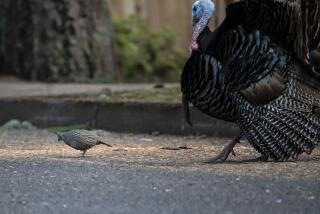Biologist Cracks Case of Adaptive Bird Behavior
JAMESTOWN, Va. — The herring gull scoops a clam out of a muddy creek, flies 200 yards to a road, rises a few feet higher, opens its bill and bam!--the clam hits the pavement.
That scene may be repeated hundreds of times a day during the winter as herring gulls on Jamestown Island use the road to crack open the hard shells so they can retrieve and eat the meat.
“They are quite resourceful,” said Daniel A. Cristol, an assistant professor of biology at the College of William and Mary, who has been studying the gulls for five years.
“The long-term question is: How do they get good at it?” Cristol said as he stood along the road, watching the gulls on a bracing, sunny day. “Is it a learned thing, or is it something that evolved long ago, somewhere else, and they just appropriated it here?”
Cristol said the skill could be innate, but his preliminary findings suggest that the behavior is consistent with learning--an example of how some animals are able to adjust their lifestyles when people alter their habitats.
Of the five species of gulls present on Jamestown Island during the winter, only herring gulls drop clams.
“I think herring gulls have the capacity to learn how to do it, and the others don’t,” Cristol said. “They learn it from one another.”
The gulls do this about two hours a day during low tide, from late November through late March.
They use the road leading to Jamestown Island, which is littered with pieces of clamshell, and also the hard surface of a small island in the creek believed to be the remains of a Civil War-era bridge. The road is better, though, because too many gulls--including the other species--lie in wait on the bridge, ready to steal the meat when a clam is dropped.
Cristol and his students collected and measured about 6,000 clamshells over three years, and it appears that the gulls favor a middle-sized clam, about 3 inches across.
Cristol speculates that a small shell isn’t worth the energy required to drop it because it doesn’t contain much meat, while a large clam is meatier but too heavy to carry.
Cristol also has noticed that the gulls usually rise up in the air a few feet before they drop the clams. He thinks they are trying to reach the most efficient dropping height. Too low, and the clam won’t break; too high, and the bird is wasting energy.
The birds seem to get better at gauging the right clam size and height as they age, Cristol said.
Cristol did similar research with crows and walnuts in California when he was a postdoctoral fellow at UC Davis.
Crows were dropping walnuts onto roadways, and some people thought this was an intelligent act because it looked like the crows were deliberately using moving vehicles as nutcrackers.
Cristol and fellow researchers observed hundreds of crows and concluded that the birds were simply dropping nuts onto any available hard surface to try to break them open.
Still, Cristol wondered if the crows had inherited the dropping technique or learned it from other crows. He brought that question with him when he came to William and Mary in 1996 and continued his research with herring gulls.
In a way, the gulls are better to study because their age can be determined by the color of their plumage, which changes from brown to white. Crows remain the same color.
“If he can age the gulls, he can track how gulls learn, or at least get started on that,” said Peter Smallwood, a behavioral ecologist and assistant professor of biology at the University of Richmond.
“His ability to age the gulls can help in trying to understand how do gulls get so good at this,” Smallwood said. “Is it instinctual? Are they able to use their experience to hone in on it by trial and error, or do they learn from each other?”
Cristol wonders whether the gulls have a mechanism for learning by observing other members of their species. Only a few instances of such so-called “social learning” have been documented.
One of the most famous examples is that of Japanese macaque monkeys, also known as snow monkeys. In the early 1950s in Japan, researchers gave sweet potatoes to a group of macaque monkeys. Imo, a young female, washed her potato in a stream before eating it.
Other monkeys began washing their potatoes as well, and today, potato washing among the monkeys is common. Some think that proves the animals can pass cultural traditions to new generations.
*
Cristol:
https://www.wm.edu/biology/Cristol.html
U.S. Geological Survey:
https://www.pif.nbs.gov/bioeco/herrgull.htm
More to Read
Sign up for Essential California
The most important California stories and recommendations in your inbox every morning.
You may occasionally receive promotional content from the Los Angeles Times.










